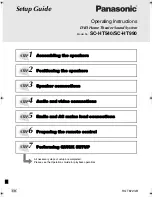
12
IREPPY - 1404 - 4238051_01
Compared to electrostatic filter the Plas-
macluster technology has four main ad-
vantages:
• In electrostatic filters the air is forced
through a metallic filter where the elec-
trostatic precipitation is produced. The
polluting particles are violently attracted
to the metal plates that make up the filter
by strong electric fields, where they then
remain energetically attached. All the pol-
lutants thus captured remain strongly at-
tached to the filter plates, and with the
use of the de-purifier, get progressively
dirtier until a visible layer of inert material
forms over time. At this point the dirt is re-
moved from the filter.
• The filter becomes a pressure drop as
it visibly gets dirty during operation, and
requires periodic cleaning as required by
its appearance. From this it can be easily
understood that over time there is a pro-
gressive degradation in filter efficiency of
such devices.
• Another important advantage is in the
electrical voltage which is around 10-12kV
for electrostatic filters, whilst for the Plas-
macluster system it is 100-200V. Some
electrostatic filters must have regulation
systems to stabilise the high voltages and
short circuit protection systems on the
high voltage of the filter itself.
• Traditional electrostatic filters, unlike the
Plasmacluster
system, only operate well in
constant operating conditions, are physi-
cally large, normally require a pre-filter to
avoid overloading the filter and frequent
maintenance.
Plasmacluster works mainly on four fronts,
described here.
The following show the results on several viruses which are sadly well known.
Virus
Reference
Environment test
volume
Exposure time of the
environment to Plasma-
cluster
Percentage of virus
made inactive
H5N1
Avian flu virus
1 cubic metre
10 minutes
99.9%
H1N1
Seasonal flu
1 cubic metre
25 minutes
99.7%
Feline coronavirus
Infective virus that at
-
tacks cats
1 cubic metre
35 minutes
99.7%
SARS
Virus that causes the
symptome known as
SARS
Test tank
3.3 seconds
73.4%
To see the action of
Plasmacluster
on vi-
ruses here are two electron microscope
images. The left shows the virus (Feline
coronavirus) before exposure and the
right the same virus inactivated from the
action of the ioniser.
Inactivation of viruses
As described above, the ions freed by
Plasmacluster
adhere to the surfaces of
microbes removing hydrogen from the pro-
tein that they are made from: this process
makes them inactive.
Numerous studies carried out by prestig-
ious European and Japanese universities
have been conducted on this matter.
Virus destroyed
Virus
Summary of Contents for RePuro 100
Page 55: ......













































